The preterite (also spelled preterit) is a commonly used Spanish past tense. Essentially, the preterite tense is used to express actions which were completed at some point in the past, had beginnings and ends, took place at or during specified time periods (days, months, etc.) or occurred in a sequence. This post explains the preterite conjugations for regular and irregular verbs as well as various uses in detail.
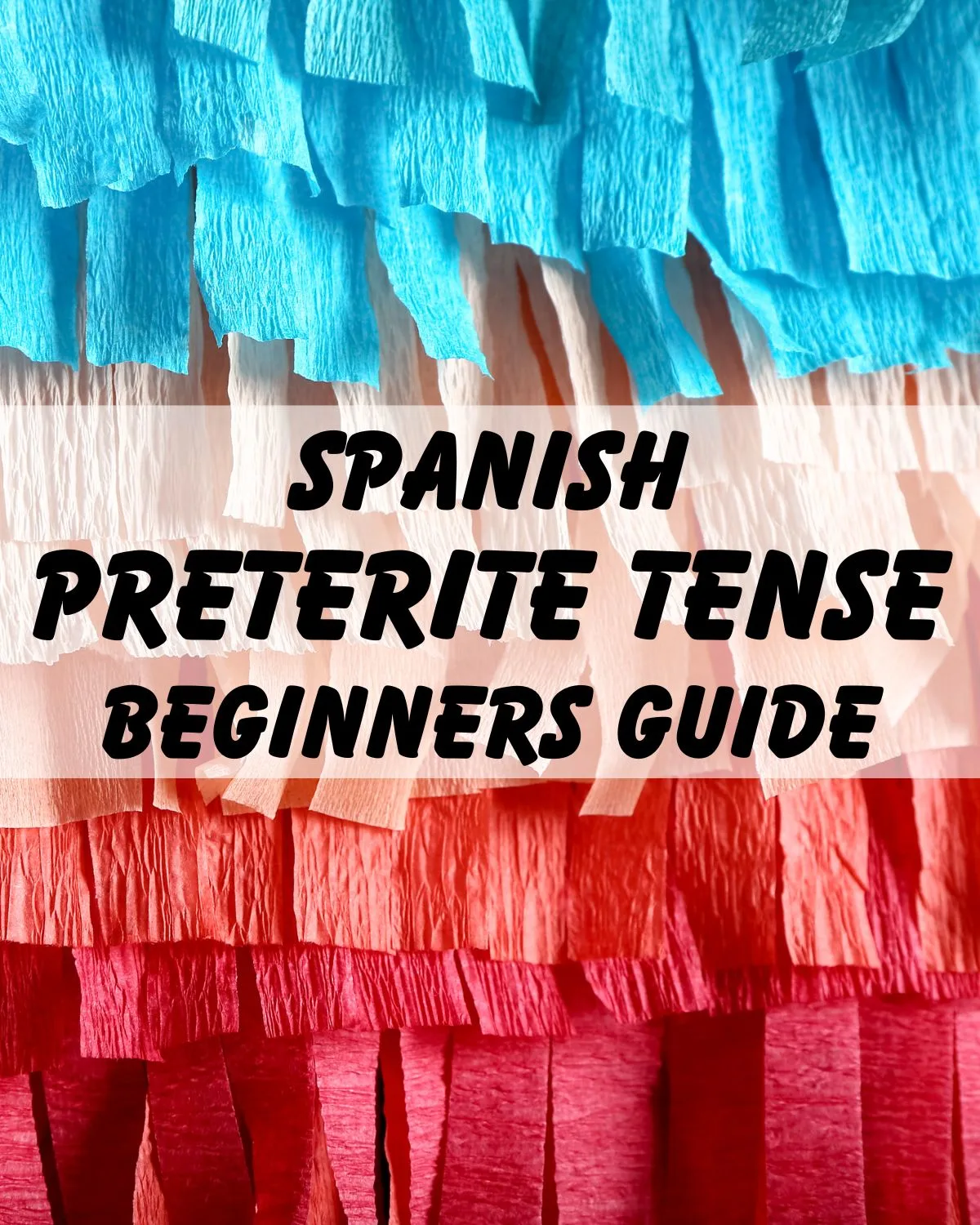
David’s tip for mastering the Spanish preterite tense
- Learning the preterite in Spanish can be daunting. As you scroll down this page you’ll see many regular and irregular forms.
- My suggestion is to focus on getting down the endings for the regular verb groups first. Specifically, focus on the sound of the endings. For example, for regular AR verbs: -e, -, aste, -ó, etc.
- Then, once you’re very clear on the SOUNDS of the preterite conjugations for the regular verbs, the irregular verbs will naturally fall into place without as much effort.
The imperfect is an another commonly used Spanish past tense. This page on our site covers the imperfect tense in detail.
Regular verbs in the preterite
Spanish has three groups of regular verbs: AR verbs, ER verbs and IR verbs. The following table shows just the preterite endings for regular verbs:
| Subject | AR Verbs | ER & IR verbs |
| yo | -é | -í |
| tú | -aste | -iste |
| él/ella, usted | -ó | -ió |
| nosotros | -amos | -imos |
| vosotros | -asteis | -isteis |
| ellos/ellas, ustedes | -aron | -ieron |
This table shows the conjugations for all three groups of regular verbs in the preterite tense. We’ve used the verbs hablar (to speak), comer (to eat) and vivir (to live) to represent each of the three major verb groups.
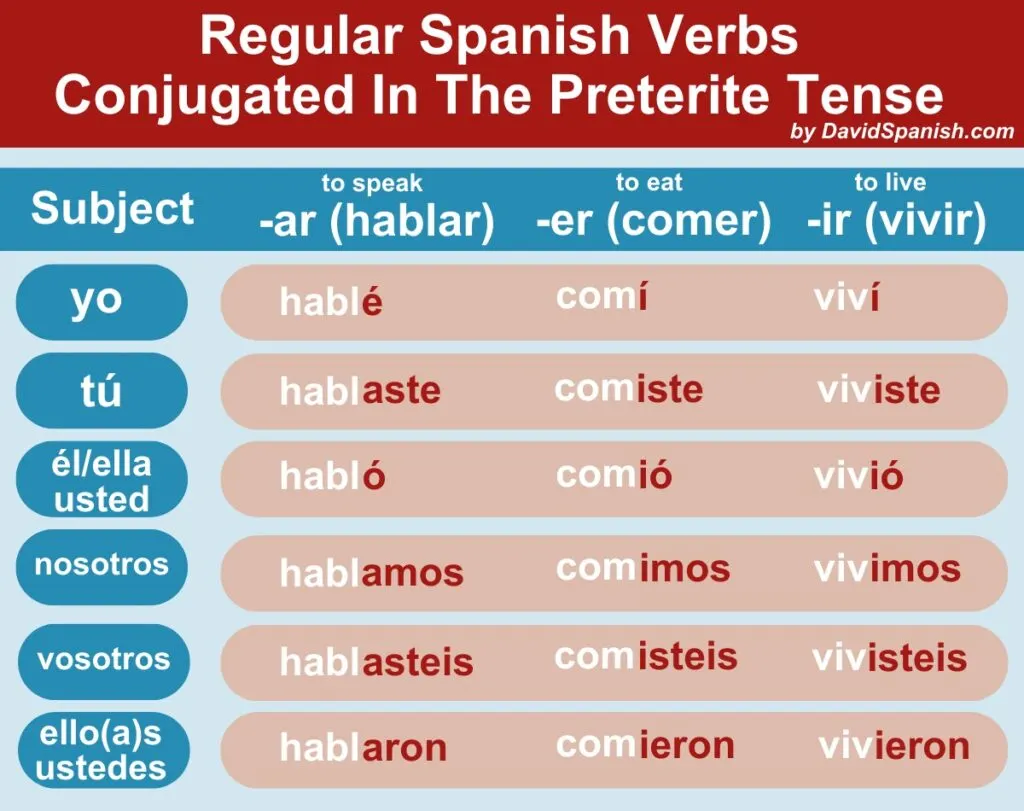
Note the following:
- The third-person plural (nosotros) form or regular AR verbs is the same for both the present and preterite tenses. This also applies to regular IR verbs.
- The preterite endings for both regular ER and IR verbs are the same.
- The present tense yo hablo (I speak) and preterite tense él/ella habló (he/she spoke) is almost the same. In the preterite form, the syllable emphasis on the second ó, as indicated by the upward slanting acute accent.
Preterite for regular verbs with spelling (stem) changes
Many verbs have spelling or stem changes in the present tense. Such changes also have an impact on the preterite tense.
For verbs with stems ending in -c, -g and -z in the present, the spellings become -qu, -gu and -c in the first-person singular (yo) form of the preterite.
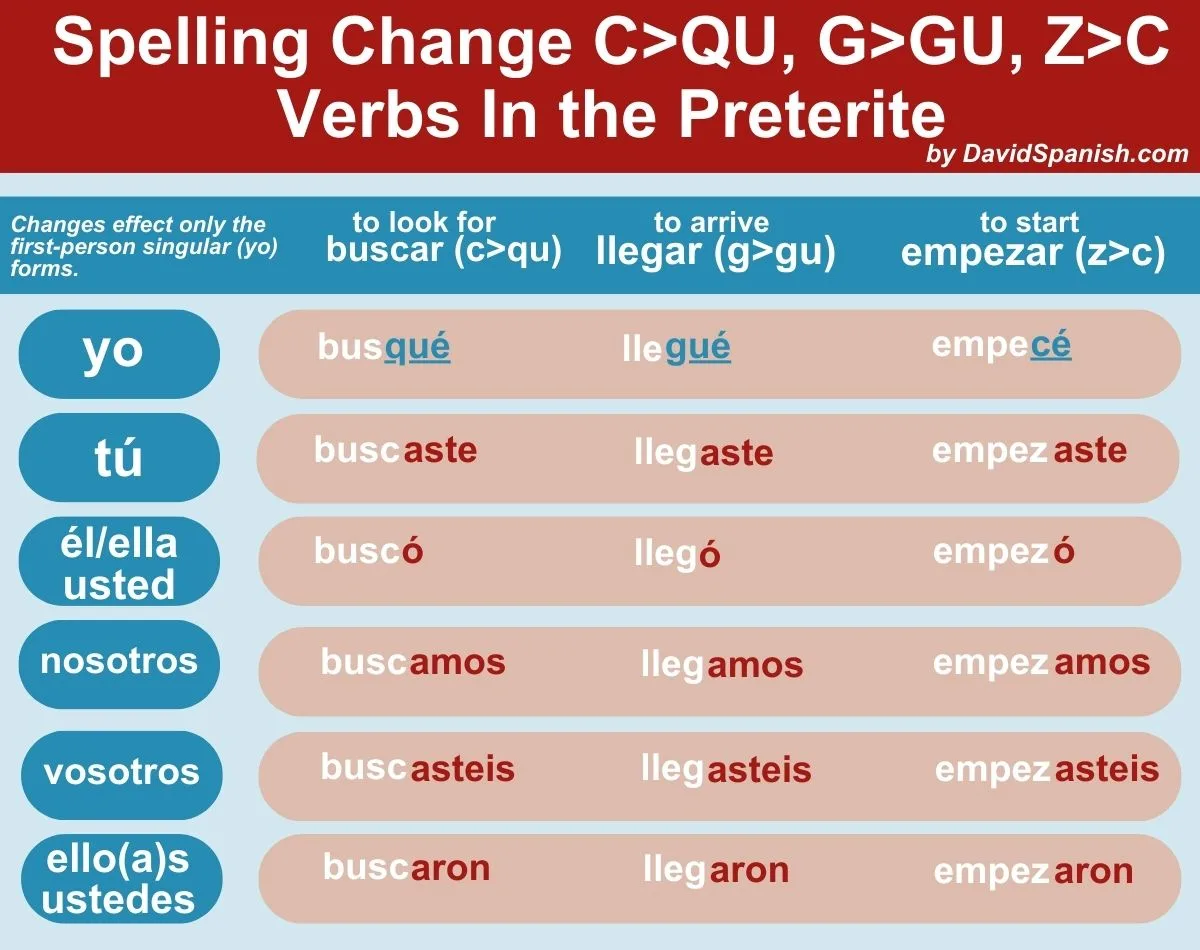
For verbs with changes e>i and o>u in the present tense, these changes affect the third-person singular (él/ella/usted) and third-person plural (ellos/ellas/ustedes) forms in the preterite.
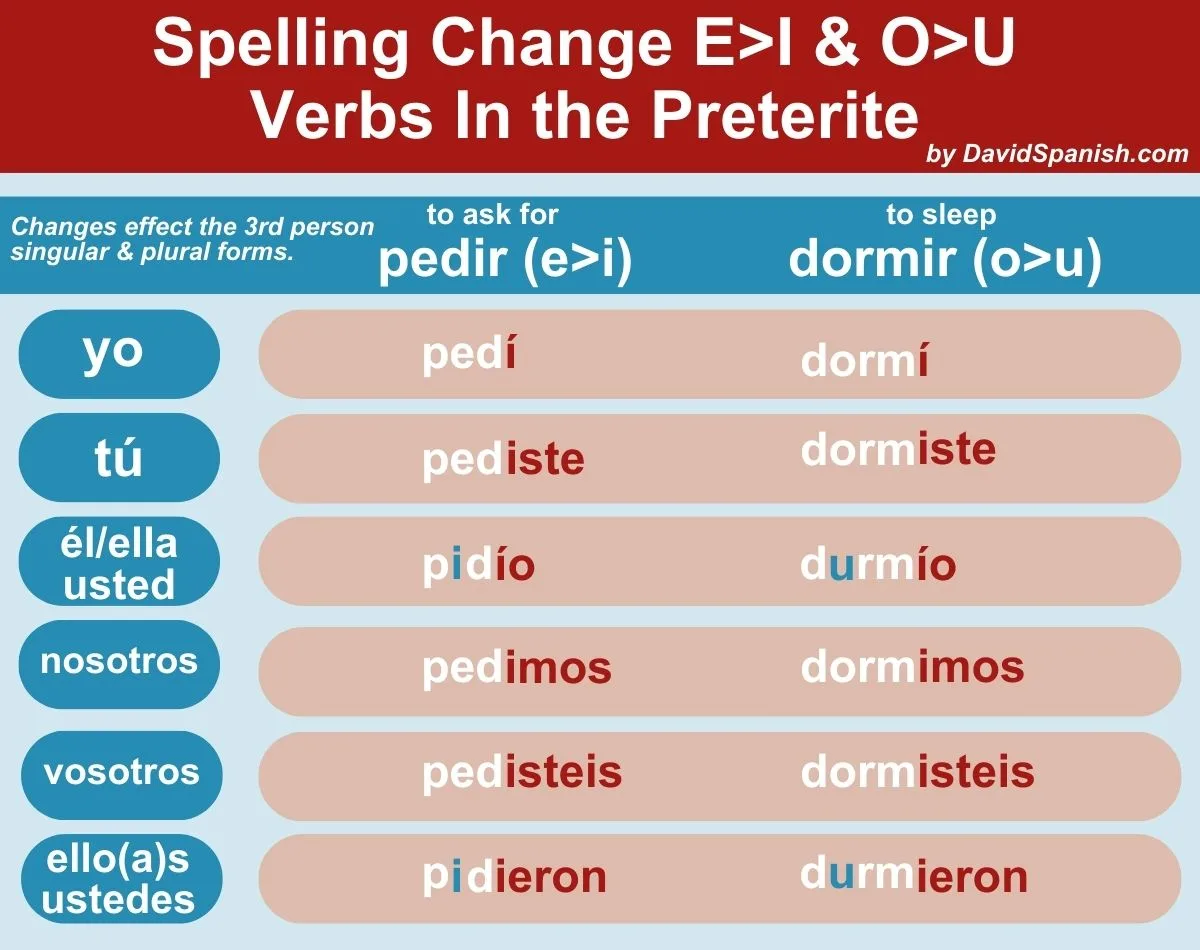
For ER and IR verbs with a vowel immediately preceding the preterite ending, the -ió becomes -yó in the third-person singular (el/ella/usted) forms and -ieron becomes -yeron in the third-person plural (ellos/ellas/ustedes) forms. In addition, an acute accent gets added to the tú, nostoros and vosotros forms.
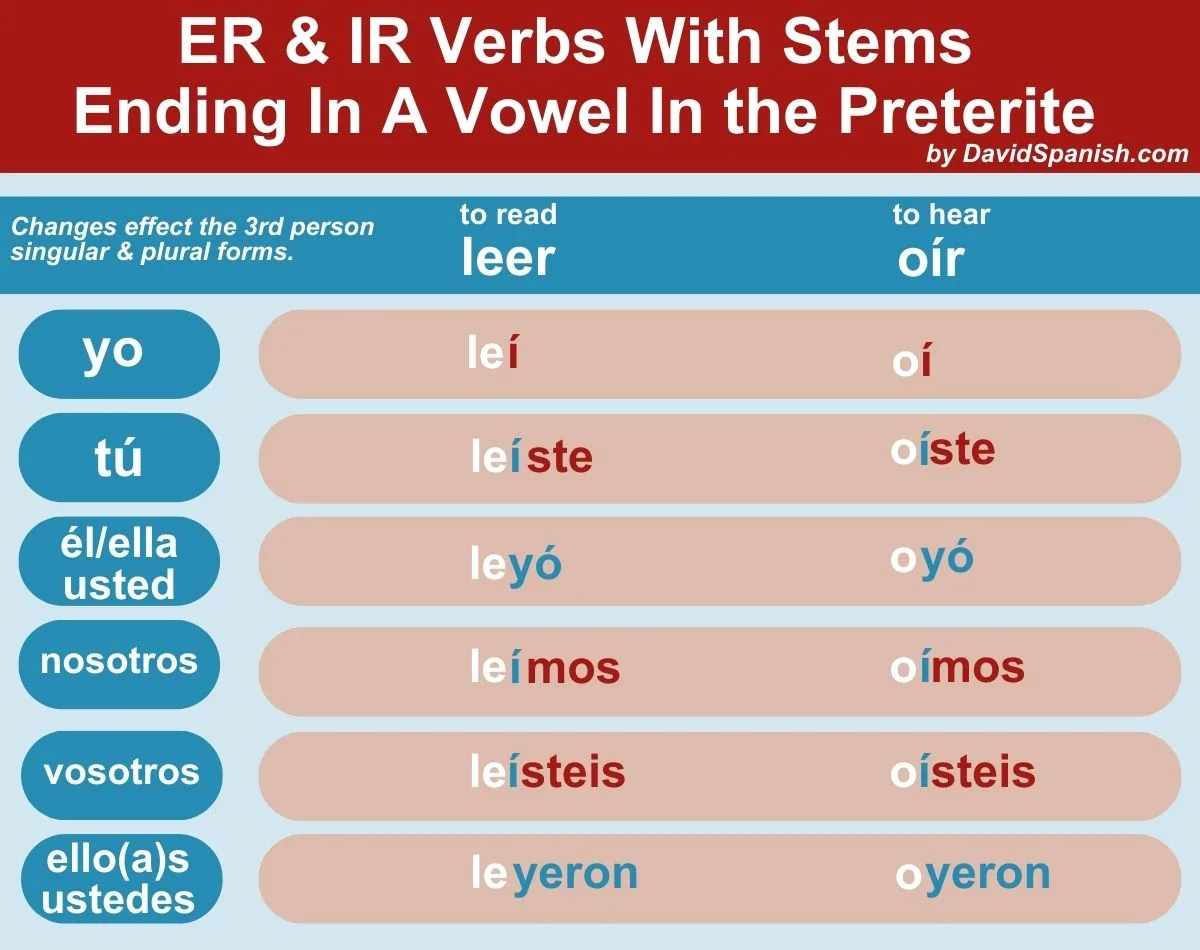
Irregular verbs in the preterite
Many Spanish verbs have irregular forms in the preterite tense. This is because they have changes in their stems or endings. These irregular verbs have the following endings: -e, iste, -o, -imos, -isteis and -ieron. This chart shows the endings:
| Subject | Ending |
| yo | -e |
| tú | -iste |
| él/ella/usted | -o |
| nosotros | -imos |
| vosotros | -isteis |
| ellos/ellas/ustedes | -ieron |
Within the group of irregular verbs in the preterite, there are four sub-groups.
Sub group 1: Verbs with uv in the stem
- andar -> anduv -> yo anduve (I walked)
- estar -> estuv-> yo estuve (I was)
- tener -> tuv -> yo tuve (I had)
Sub group 2: Verbs with u in the stem
- haber -> hub -> yo hube (I had to, was)
- poder -> pud -> yo pude (I was able, could)
- poner -> pus -> yo puse (I put)
- saber -> sup -> yo supe (I knew)
Sub group 3: verbs with i in the stem
- hacer -> hic -> yo hice (I made, did)
- querer -> quis -> yo quise (wanted, loved)
- venir -> vin -> yo vine (I came)
Sub group 4: verbs with j in the stem
- atraer -> atraj -> yo atraje (I attracted)
- decir -> dij -> yo dije (said)
- producir -> produj -> yo produje (I produced)
- traer -> traj -> yo traje (I brought)
- traducir -> traduj -> yo traduje (I translated)
Thus, to conjugate these irregular verbs in the preterite tense, use the following formula:
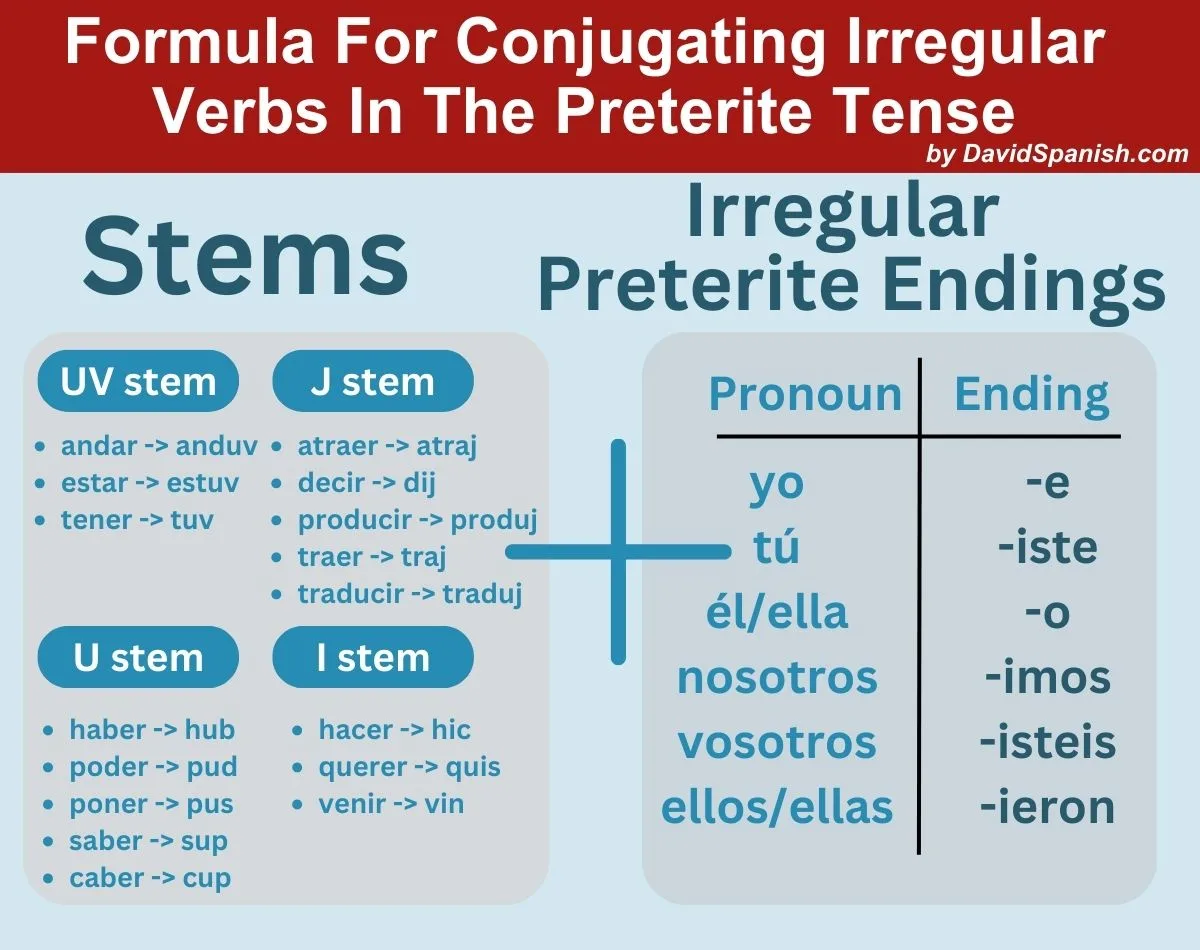
Preterite for ser and ir
Interestingly, the preterite conjugations for ser (to be) and ir (to go) are the exact same. Thus, the verbs’ meanings become very apparent based on context. For example:
- Yo fui muy rico y famoso. I was very rich and famous.
- Yo fui a la playa. I went to the beach.
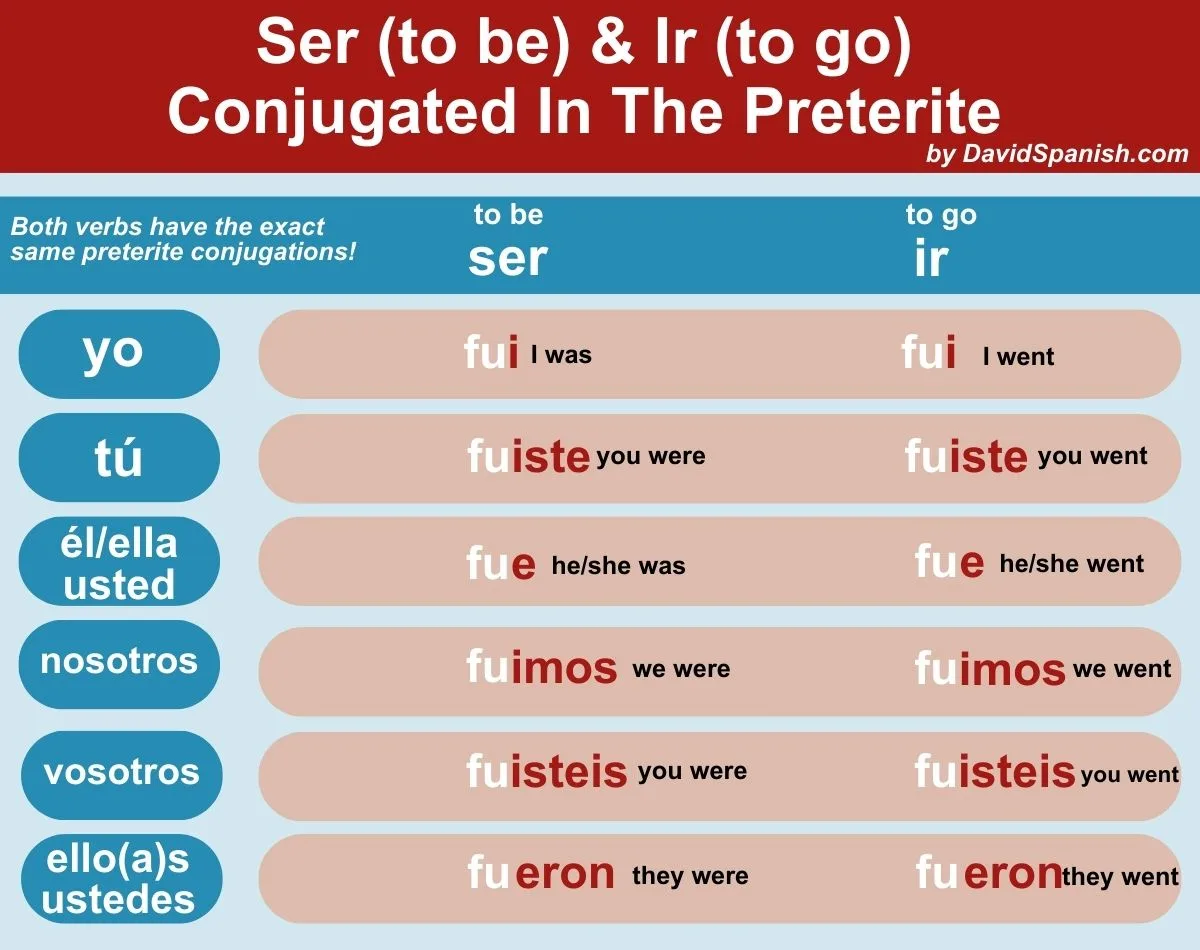
Preterite for dar (to give)
The verb dar (to give) takes the regular ER and IR preterite endings but doesn’t have the accents.
| yo di | I gave |
| tú diste | you gave |
| él/ella/usted dio | he, she, you gave |
| nosotros dimos | we gave |
| vosotros disteis | you gave |
| ellos/ellas/ustedes dieron | you, they gave |
Uses the Spanish Preterite Tense
1. Completed past actions
A key situation when to use the preterite tense in Spanish is when a past action has been completed.
- Yo compre el coche. I bought the car.
This is an example of a past action which has been completed. I purchased the car – the process of the purchase is complete.
2. Specified time the action occurred
Use the preterite to express which occurred at a specified time.
- Yo fui a la playa ayer. I went to the beach yesterday.
In this sentence, the timing of the visit to the beach is very clear: yesterday. Use the preterite when the time is mentioned.
3. Specified duration of time
Use the preterite if the length of time that an actions occurred is specified.
- Espere una hora en la cola. I waited in the line for one hour.
4. Sequence of actions
Use the preterite when describing a series of past action which occurred one after the other.
- Yo llegué en la casa, prepare la cena y la comí. I arrived home, prepared the meal and ate it.
5. Actions which only occurred one time
Use the preterite to express past actions which logically occurred just one time in the past.
- Yo complí cuarenta años. I turned forty years-old.
- Yo decidí estudiar español. I decided to study Spanish.
- Yo descubrí la solución. I discovered the solution.
Trigger phrases for the preterite
Certain phrases are trigger words for the preterite. This is because they describe specified times and apply to actions which only occurred once.
Here are some examples of trigger phrases for the preterite:
- ayer yesterday
- ayer en la mañana yesterday morning
- ayer en la tarde yesterday afternoon
- anoche yesterday evening, last night
- anteayer the day before yesterday
- una vez once, once time
- en aquel momento at that moment
- la semana pasada last week
- el mes pasado last month
- el año pasado last year
- el primero de marzo March 1st (example of a date)
- en mil novecientos ochenta y cuatro in 1984 (example of a year)
Conclusion – Where to go from here
I hope this post covering the Spanish preterite has been useful. The main point is that the preterite is used for past completed actions, past actions with specified times and durations, past actions which only happened once and series of events.
I have found that the book The Ultimate Spanish Review and Practice has been an excellent resource for helping students to master the preterite. Specifically, chapter 4 of the book offers an excellent series of exercises which would be a good follow-up to this page.
Discover more:
- Conocer (to know) conjugation
- Saber (to know) conjugation
- Hacer Conjugation
- Hablar (to speak) conjugation
- Reflexive Verbs In Spanish: Everything You Need To Know - April 7, 2024
- Cielito Lindo Lyrics, Meaning & Translation - November 24, 2023
- Spanish Commands: The Imperative Mood Clearly Explained - November 22, 2023
